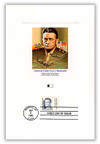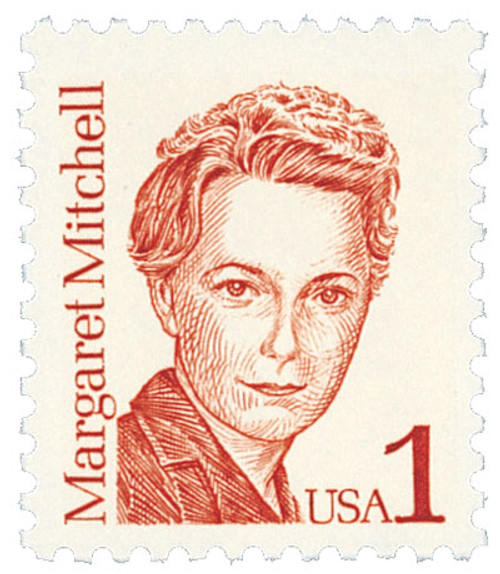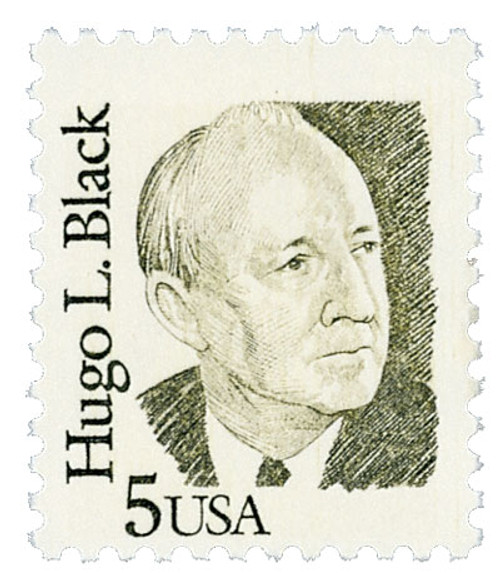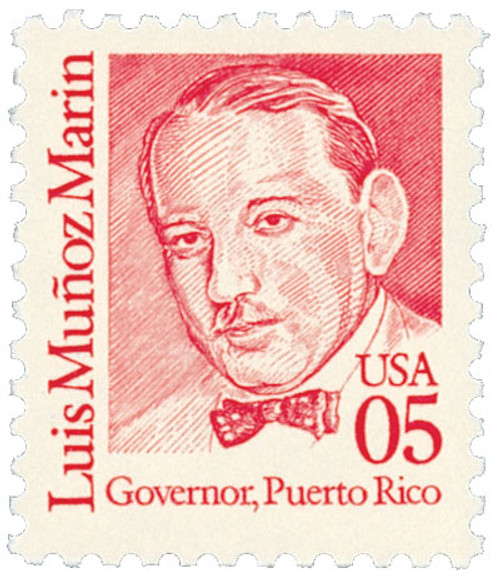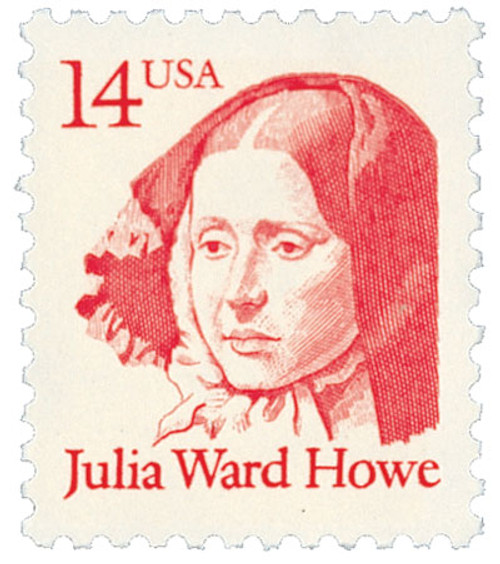
# 2187 FDC - 1990 40c Great Americans: Claire Chennault
U.S. #2187
1990 40¢ Claire Chennault
Great Americans
- Issued on Chennault’s 97th birthday (originally believed to be his 100th, as Chenault had several different birthdates on record)
- Paid the one-ounce overseas surface rate
Stamp Category: Definitive
Series: Great Americans
Value: 40¢, the one-ounce overseas surface rate
First Day of Issue: September 6, 1990
First Day City: Monroe, Louisiana
Quantity Issued: 45,00,000
Printed by: Bureau of Engraving and Printing
Printing Method: Engraving
Format: Panes of 100 in sheets of 800
Perforations: 11.2
Color: Dark blue
Why the stamp was issued: To replace the 1984 Lillian Gilbreth stamp, paying the one-ounce overseas surface rate.
About the stamp design: Chris Calle, the artist behind nine prior Great Americans stamps, used several photos in his many preliminary sketches for this stamp. The final portrait was largely based on a war-time photo picturing Chennault with two stars on his shoulder, designating him as a major general.
First Day City: The First Day ceremony for this stamp was held at the Anna Gray Noe Alumni Center at Northeast Louisiana University in Monroe. The day’s celebrations included a fly-by of World War II-era aircraft.
About the Great Americans Series: The Great Americans Series was created to replace the Americana Series. The new series would be characterized by a standard definitive size, simple design, and monochromatic colors.
This simple design included a portrait, “USA,” the denomination, the person’s name, and in some cases, their occupation or reason for recognition. The first stamp in the new series was issued on December 27, 1980. It honored Sequoyah and fulfilled the new international postcard rate that would go into effect in January 1981.
The Great Americans Series would honor a wider range of people than the previous Prominent Americans and Liberty Series. While those series mainly honored presidents and politicians, the Great Americans Series featured people from many fields and ethnicities. They were individuals who were leaders in education, the military, literature, the arts, and human and civil rights. Plus, while the previous series only honored a few women, the Great Americans featured 15 women. This was also the first definitive series to honor Native Americans, with five stamps.
The Bureau of Engraving and Printing (BEP) produced most of the stamps, but private firms printed some. Several stamps saw multiple printings. The result was many different varieties, with tagging being the key to understanding them. Though there were also differences in perforations, gum, paper, and ink color.
The final stamp in the series was issued on July 17, 1999, honoring Justin S. Morrill. Spanning 20 years, the Great Americans was the longest-running US definitive series. It was also the largest series of face-different stamps, with a total of 63.
Click here for all the individual stamps and click here for the complete series.
History the stamp represents: Claire Lee Chennault was born on September 6, 1893 (though he claimed 1890 sometimes), in Commerce, Texas. Chennault spent his early years in Louisiana, attended Louisiana State University, and joined the ROTC. He worked as a school principal until the outbreak of World War I, at which point he joined the Army Signal Corps. Chennault went on to fly with the Army Air Service during that war.
After World War I, Chennault was made Chief of Pursuant Section at the Air Corps Tactical School. He also led the 1st Pursuit Group Army Air Corps aerobatic team, the Three Musketeers, which he later reorganized as the Three Men on the Flying Trapeze.
By the mid-1930s, Chennault’s health was suffering and he fought with superiors after he was passed over for a promotion. So he retired from the military on April 30, 1937. He was then invited to join a small group of American civilians in China training their airmen.
Shortly after Chennault’s arrival in China, the Second Sino-Japanese War broke out and he was made chief air advisor to Chiang Kai-shek. In this role, he trained Chinese Air Force pilots and flew on occasional scouting missions. Then in 1940, he traveled back to the US to request more planes and pilots. From this meeting came the creation of the American Volunteer Group, also known as the Flying Tigers. The US promised 100 planes as well as mechanics, pilots, and aviation supplies.
Chennault planned and campaigned for a bombing raid by his tigers, which he believed could end the war. The raid never happened because airfields weren’t built close enough to Japan to launch the planes. Then on December 20, 1941, Chennault’s Tigers shot down four Japanese planes bound for Kunming.
The Tigers continued to guard the Burma Road, Rangoon, and other important locations in Southeast Asia and Western China. Eventually, Chennault rejoined the Army and the Tigers were formally incorporated into the US Army Air Forces.
After the war, Chennault returned to China and created Civil Air Transport (later Air America) to aid Nationalist China in its struggle against Communist China. He was eventually promoted to lieutenant general in the Air Force nine days before his death on July 27, 1958.
U.S. #2187
1990 40¢ Claire Chennault
Great Americans
- Issued on Chennault’s 97th birthday (originally believed to be his 100th, as Chenault had several different birthdates on record)
- Paid the one-ounce overseas surface rate
Stamp Category: Definitive
Series: Great Americans
Value: 40¢, the one-ounce overseas surface rate
First Day of Issue: September 6, 1990
First Day City: Monroe, Louisiana
Quantity Issued: 45,00,000
Printed by: Bureau of Engraving and Printing
Printing Method: Engraving
Format: Panes of 100 in sheets of 800
Perforations: 11.2
Color: Dark blue
Why the stamp was issued: To replace the 1984 Lillian Gilbreth stamp, paying the one-ounce overseas surface rate.
About the stamp design: Chris Calle, the artist behind nine prior Great Americans stamps, used several photos in his many preliminary sketches for this stamp. The final portrait was largely based on a war-time photo picturing Chennault with two stars on his shoulder, designating him as a major general.
First Day City: The First Day ceremony for this stamp was held at the Anna Gray Noe Alumni Center at Northeast Louisiana University in Monroe. The day’s celebrations included a fly-by of World War II-era aircraft.
About the Great Americans Series: The Great Americans Series was created to replace the Americana Series. The new series would be characterized by a standard definitive size, simple design, and monochromatic colors.
This simple design included a portrait, “USA,” the denomination, the person’s name, and in some cases, their occupation or reason for recognition. The first stamp in the new series was issued on December 27, 1980. It honored Sequoyah and fulfilled the new international postcard rate that would go into effect in January 1981.
The Great Americans Series would honor a wider range of people than the previous Prominent Americans and Liberty Series. While those series mainly honored presidents and politicians, the Great Americans Series featured people from many fields and ethnicities. They were individuals who were leaders in education, the military, literature, the arts, and human and civil rights. Plus, while the previous series only honored a few women, the Great Americans featured 15 women. This was also the first definitive series to honor Native Americans, with five stamps.
The Bureau of Engraving and Printing (BEP) produced most of the stamps, but private firms printed some. Several stamps saw multiple printings. The result was many different varieties, with tagging being the key to understanding them. Though there were also differences in perforations, gum, paper, and ink color.
The final stamp in the series was issued on July 17, 1999, honoring Justin S. Morrill. Spanning 20 years, the Great Americans was the longest-running US definitive series. It was also the largest series of face-different stamps, with a total of 63.
Click here for all the individual stamps and click here for the complete series.
History the stamp represents: Claire Lee Chennault was born on September 6, 1893 (though he claimed 1890 sometimes), in Commerce, Texas. Chennault spent his early years in Louisiana, attended Louisiana State University, and joined the ROTC. He worked as a school principal until the outbreak of World War I, at which point he joined the Army Signal Corps. Chennault went on to fly with the Army Air Service during that war.
After World War I, Chennault was made Chief of Pursuant Section at the Air Corps Tactical School. He also led the 1st Pursuit Group Army Air Corps aerobatic team, the Three Musketeers, which he later reorganized as the Three Men on the Flying Trapeze.
By the mid-1930s, Chennault’s health was suffering and he fought with superiors after he was passed over for a promotion. So he retired from the military on April 30, 1937. He was then invited to join a small group of American civilians in China training their airmen.
Shortly after Chennault’s arrival in China, the Second Sino-Japanese War broke out and he was made chief air advisor to Chiang Kai-shek. In this role, he trained Chinese Air Force pilots and flew on occasional scouting missions. Then in 1940, he traveled back to the US to request more planes and pilots. From this meeting came the creation of the American Volunteer Group, also known as the Flying Tigers. The US promised 100 planes as well as mechanics, pilots, and aviation supplies.
Chennault planned and campaigned for a bombing raid by his tigers, which he believed could end the war. The raid never happened because airfields weren’t built close enough to Japan to launch the planes. Then on December 20, 1941, Chennault’s Tigers shot down four Japanese planes bound for Kunming.
The Tigers continued to guard the Burma Road, Rangoon, and other important locations in Southeast Asia and Western China. Eventually, Chennault rejoined the Army and the Tigers were formally incorporated into the US Army Air Forces.
After the war, Chennault returned to China and created Civil Air Transport (later Air America) to aid Nationalist China in its struggle against Communist China. He was eventually promoted to lieutenant general in the Air Force nine days before his death on July 27, 1958.





